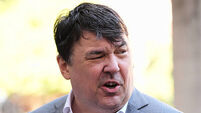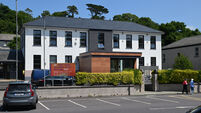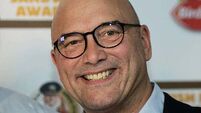Glucksman exhibition features artists in front of the camera

It is co-curated by Glucksman director Fiona Kearney and Marco Pierini, and includes more than 80 works from the collection of the Galleria Civica di Modena in Italy.
The earliest photograph in the show is a portrait of a painter named Anton Räderscheidt. This was taken in 1927 by one of the best-known photographers of the early 20th century, August Sander. Entitled ‘Painter’, it is one of a series Sander made called ‘Face of Our Time’, where he took documentary portraits of ordinary people based on their profession.
Sander played with the notion of artists being out on the streets documenting the world, and photographed Räderscheidt at 6am on a deserted street in Cologne. This set the portrait apart from the rest of the series, as Räderscheidt is without his painting equipment in a street devoid of its work-day traffic.
The striking colour of Elina Brotherus’s self-portrait sets it apart from the predominantly black-and-white work in the show. “She’s very deliberately used very glaring lemon yellows to unsettle you,” says Kearney. “She’s questioning everything it is to be an artist. Is it the hand? The eye?”
Brotherus is emulating Rodin’s Thinker, and has set up the pose so that her gaze makes eye contact with the viewer. A yellow Post-it stuck to the back of her hand has ‘Le Main’ scribbled on it, a juxtaposition of modern throwaway culture with the monumental nature of Rodin’s sculpture.
Close by is a smaller, quieter self-portrait by Francesca Woodman. “It’s a very sad story because she committed suicide very young,” says Kearney. “I think she was only 22, a precocious talent, and certainly every sign was there that she was going to be a genius of her practice. It became an unfulfilled moment.
“Woodman is very interested in setting up a photograph as a constructed image that had multiple meanings for the reader. This is much less about ‘Who is Francesca Woodman?’ and much more interesting in terms of ‘What are we looking at?’, ‘What are we seeing?’.
“Woodman is not married but she’s put on a wedding ring and she has used the calla lily which is traditionally the sign of the annunciation. It is like a modern day annunciation. There is an interesting darkness in many of her images, as if she’s almost disappearing or receding into walls. Always hiding and opening up at the same time. Even though she’s completely naked she’s covered up.
“It’s a beautiful print. With the tonal qualities, she makes such an extraordinary use of the velvety black through to the greys and into the intense white light that’s coming down on her in the same way the ray would settle on the Virgin.”
They say the camera never lies, but photographs can, of course, be manipulated. They can be finished works of art in themselves, or can document what happens in a moment, such as performance art.
Joseph Beuys was a pioneering performance artist. It stands to reason that ‘Bog Action’, a photograph of Beuys immersed in bogwater, would be a document of one such performance. Intriguingly, it is not. Beuys engaged photographer Gianfranco Gorgoni to create this image as part of his social activism. He has constructed an image that portrays him undertaking a performance, but , it is a posed set-up, one that Beuys intended would raise awareness about endangered boglands around the world.
The artist and musician Laurie Anderson is photographed in the quiet moments leading up to a performance on violin. This is an especially intimate portrait, as Anderson is caught tuning up her instrument and quietly squaring up to her stage persona.
Annie Leibovitz is one of the megastars in the exhibition. Her portrait of John Lennon and Yoko Ono was taken only hours before Lennon was assassinated.
“This is probably one of the most iconic images in the show,” says Kearney. “When you look up close you see, as a lot of people don’t realise, that it was taken on the floor.
“Leibovitz apparently wanted the two of them to pose naked, but only Lennon got his clothes off. It creates this extraordinary photograph, because Yoko is clothed and just lying there, and he’s around her — a lot of people say, foetal like — in his embrace. One of the reasons why it feels a little bit surreal is the fact that he’s nearly completely hairless.
“Leibovitz’s photographs became a set of images deciding the final idea of who Lennon was. One of the things that happened was that this became a defining idea of who they were as a couple.
“If Lennon had survived, other photographs would have been taken of them. Instead we have this, anchored as the idea of what their relationship was.
“Yoko Ono is an extraordinary artist in her own right, a wonderful visual artist. She probably went through quite a difficult time. A lot of the Beatles’ fans and John Lennon fans resented her and saw this image as his total need for her. It’s only now people are coming around to how much she has honoured his legacy but also followed her own artistic path.”
The final photograph in the show is a complex image: a portrait of Richard Long, standing in a gallery in front of one of his stone installations.
Long works in performance, sculpture and photography. He is best known for his walks in the landscape that often appear as documentary photographs in galleries. Similarly, his gallery installations only exist for the duration of the exhibition, but they live on through a photographic record. Long’s art practice poses many of the same questions as ‘The Artist’s Eye’ exhibition.
“What is the legacy of an artist?” says Kearney. “Should we be so interested in the artist or should we be more interested in the work? I think all artists will say it’s about the work. I think that idea of the artist becoming effaced by the work is demonstrated because the work will live on long after all these artists are dead and gone.”
* Runs until July 7










